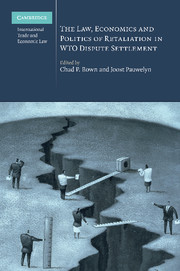Book contents
- Frontmatter
- Contents
- List of tables and figures
- Contributors
- Introduction: trade retaliation in WTO dispute settlement: a multi-disciplinary analysis
- PART I Background and goal(s) of WTO retaliation
- PART II A legal assessment after ten arbitration disputes
- PART III An economic assessment after ten arbitration disputes
- PART IV The domestic politics and procedures for implementing trade retaliation
- PART V Problems and options for reform
- PART VI New frontiers and lessons from other fields
- Index
Introduction: trade retaliation in WTO dispute settlement: a multi-disciplinary analysis
Published online by Cambridge University Press: 26 February 2010
- Frontmatter
- Contents
- List of tables and figures
- Contributors
- Introduction: trade retaliation in WTO dispute settlement: a multi-disciplinary analysis
- PART I Background and goal(s) of WTO retaliation
- PART II A legal assessment after ten arbitration disputes
- PART III An economic assessment after ten arbitration disputes
- PART IV The domestic politics and procedures for implementing trade retaliation
- PART V Problems and options for reform
- PART VI New frontiers and lessons from other fields
- Index
Summary
It is hard to think of a better topic for multi-disciplinary study than trade retaliation in the WTO. When a country violates WTO rules, the remedy of last resort is bilateral, state-to-state trade sanctions. Such trade sanctions are imposed against the violating country by one or more other WTO members who took the initiative to challenge the breach. WTO retaliation must, however, be multilaterally authorized by the WTO following, first, an elaborate procedure establishing (continued) breach in the first place and, second, an arbitration on whether the retaliation is ‘equivalent’ or ‘appropriate’ in the light of the harm caused by the original violation. This is where the law comes in: arbitrators must apply legal criteria to assess the harm caused by a WTO violation, select benchmarks and counterfactuals to do so, as well as decide, where requested, on whether the conditions for so-called cross-retaliation are met (that is, retaliation in the form of, for example, suspending intellectual property rights in response to a WTO-inconsistent import restriction). This process obviously involves economics as well, both economic theory (what is the role of violation-cum-retaliation in an incomplete contract?; what is the optimal design of remedies for breach of contract?) and applied or quantitative economics (how does one calculate lost trade, lost royalties or other economic harm caused by a WTO violation?; how does one make sure that the retaliation in response is ‘equivalent’?).
- Type
- Chapter
- Information
- Publisher: Cambridge University PressPrint publication year: 2010
- 1
- Cited by

